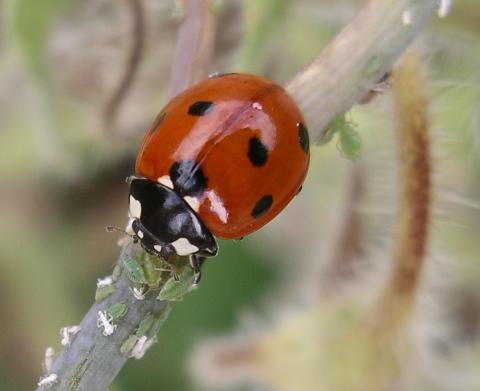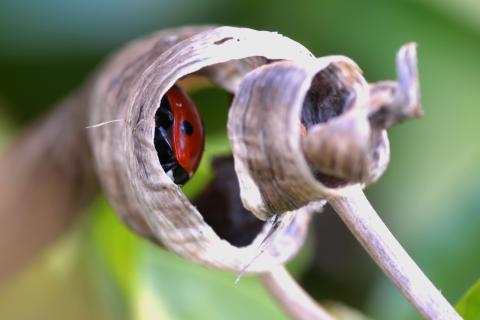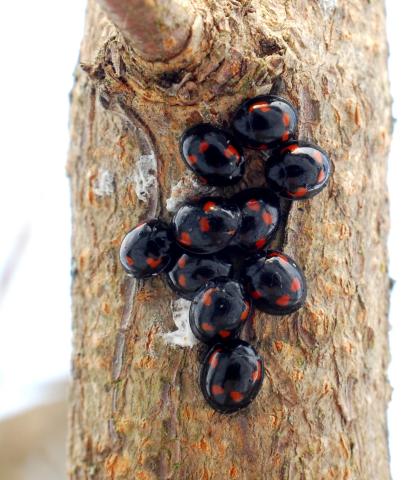A report into the global status of ladybirds reveals the threats they face and lays out a roadmap for conservation. These vital pest controllers for farmers and gardeners are considered to be in decline globally due to human activities, and species are poorly understood.
The survey’s authors call for greater citizen science efforts to encourage more people to record ladybirds around the world. They also urge conservation efforts to protect habitats, in particular the sites that ladybirds rely on to survive the adverse conditions of winters.
The research was compiled by an international group of experts, including ecologists at the UK Centre for Ecology & Hydrology, University of the Azores, and Ghent University, as well as all members of the IUCN SSC Ladybird Specialist Group. It identifies gaps in knowledge about how ladybirds are responding to environmental changes affecting global biodiversity while suggesting actions to protect ladybirds and other insects.

The ladybird family – Coccinellidae – includes more than 6,000 species globally with 47 found in the UK. Many species of ladybird play an important role in protecting plants – including crops – from the ravages of pest insects including aphids. There is considerable concern that insects, including ladybirds, globally may be in decline, but information is lacking to assess the magnitude of the problems caused by threats such as changes in climate, land use and pollution, and invasive non-native species.
Dr António Onofre Soares, a lead author and a researcher at University of the Azores says: “This paper brings together a global community to consider the status of ladybirds and how they fit into the bigger insect picture around the world. We hope the result will be that ladybirds become a larger part of the conservation agenda by highlighting areas where there is a need for data and what can be done in terms of tangible actions.”
Dr Danny Haelewaters, a lead author and a researcher at Ghent University says: "Ladybirds have many functions within our ecosystems but at present suffer from a lack of global collaborative research. Alongside ecologists, the ladybird conservation community is still awaiting the first Red List assessments to help inform conservation strategies. I hope we can enthuse more researchers to become involved in studying ladybirds and assessing the ecological threats that impact their diversity and abundance.”
In recent years people have taken actions to manage their gardens to provide habitats for bees through bee homes and campaigns such as “no mow May” to increase the abundance of flowering plants which provide an important resource for pollinators. These benefit other insects such as ladybirds, but there are simple measures that people can also implement to further increase the value of their gardens for a diverse range of insects.

Actions include ensuring there are flowers to provide nectar throughout insects’ active period, in spring and summer, and leaving pest species on roses and vegetables as a food source for predatory ladybirds. Leaves left on the ground in autumn provide overwintering habitat.
Professor Helen Roy, an ecologist at the UK Centre for Ecology & Hydrology and one of the paper’s authors, says: “Over the last few decades we have seen more and more people getting involved with ladybird surveys contributing their sightings of ladybirds through citizen science initiatives around the world. In this exciting new paper we explore ways that everyone can make a difference and contribute to the conservation of ladybirds and other insects.”
As well as public involvement, the research highlights how environmental change is impacting ladybirds and focuses on addressing ways to counter the ongoing threats faced by ladybirds.
In the paper, published in Conservation Biology, the team has laid out a roadmap with short-, medium- and long-term actions that are needed for ladybird conservation and recovery. These actions include:
• Recruiting citizen scientists for data collection and observations, education programmes and conservation efforts
• Enhancing agricultural landscapes by creating insect-friendly habitats
• Education programmes to target different audiences
• Introducing machine learning to support long-term monitoring, for example using cameras coupled with deep learning software to monitor insects
• Bringing together national monitoring systems globally

Professor Roy adds: “Ladybirds are well-loved, charismatic insects but we know so little about them. This paper brings together a global team and sets out ways that we can safeguard the future of these amazing beetles. It is critical that we consider the multiple drivers of environmental change together and increase our understanding of the ways in which climate change, land-use change and biological invasions interact with one another. We need to act fast and act together.”
–ENDS–
Notes to editors
A roadmap for ladybird conservation and recovery is published in Conservation Biology, DOI: 10.1111/cobi.13965
The authors’ institutions are listed below:
• Center for Ecology, Evolution and Environmental Changes / Azorean Biodiversity Group (cE3c–ABG) / CHANGE – Global Change and Sustainability Institute, University of the Azores, Portugal
• IUCN SSC Ladybird Specialist Group
• Ghent University, Ghent, Belgium
• University of South Bohemia, Czech Republic
• Czech Academy of Sciences, Czech Republic
• University of Aveiro, Portugal
• Anglia Ruskin University, UK
• Finnish Museum of Natural History, University of Helsinki, Finland
• Research Institute for Nature and Forest (INBO), Belgium
• Utah State University, USA
• Universidad de Chile, Chile
• Trier University, Germany
• IUCN SSC Invertebrate Conservation Committee
• Comenius University, Slovak Republic
• Crop Research Institute, Czech Republic
• Slovak Academy of Sciences, Slovak Republic
• Kansas State University, USA
• University of Lucknow, India
• UK Centre for Ecology & Hydrology, UK
• National Research Institute for Agriculture, Food and the Environment (INRAE) & Aix-Marseille University, France
• Pontificia Universidad Católica de Chile, Chile
• Cornell University, USA
Media enquiries
Photos are available on request. For interviews and further information, please contact Simon Williams, Media Relations Officer at UKCEH, via simwil@ceh.ac.uk or +44 (0)7920 295384.
About the UK Centre for Ecology & Hydrology (UKCEH)
The UK Centre for Ecology & Hydrology is a centre for excellence in environmental science across water, land and air. Our 500-plus scientists work to understand the environment, how it sustains life and the human impact on it – so that together, people and nature can prosper.
We have a long history of investigating, monitoring and modelling environmental change, and our science makes a positive difference in the world.
The UK Centre for Ecology & Hydrology is a strategic delivery partner for the Natural Environment Research Council, part of UK Research and Innovation.
www.ceh.ac.uk / @UK_CEH / LinkedIn: UK Centre For Ecology & Hydrology
About the International Union for Conservation of Nature (IUCN)
IUCN is an international organization working in the field of nature conservation and sustainable use of natural resources. Its Red List is a critical indicator of the health of the world’s biodiversity. IUCN provides information about range, population size, habitat and ecology, use and/or trade, threats, and conservation actions that will help inform necessary conservation decisions.